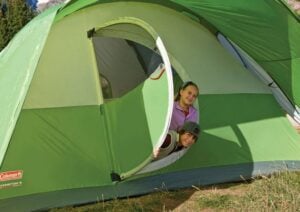As a camper, you know that making the right purchase decisions is important. After all, you don’t want to be stuck out in the wilderness with a faulty tent or faulty sleeping bags.
But what about when it comes to buying a tent footprint? Are tent footprints necessary, or are they just another added expense?
In this article, we’ll explore the basics of tent footprints, how to properly use them to protect your tent floor, and how you can get by with a free DIY tent footprint.
Armed with this information, you can make an informed decision about whether or not a tent footprint is worth it for you.
What is a tent footprint?
A tent footprint is a waterproof covering that goes beneath the base of your tent to keep water out. It also protects the surface beneath your tent from wear and tear. Some tents come with footprints already attached, while others do not. If you’re unsure whether or not your tent has a footprint, it’s best to ask the tent manufacturers before purchasing.
🏔 When is it worth having a tent footprint?
Generally, you’ll want to use a tent footprint when camping on rough or rocky terrain, as it will protect your tent’s base from getting scratched or punctured. The last thing you want is for a sharp rock to tear a hole in your tent floor, and only find out about it when you’re already miles from the nearest town.
This is where a footprint can be incredibly worth it.
What are the Different Types of Tent Footprints
There are a few different types of tent footprints to choose from, and each has its own advantages and disadvantages. Here are the most common types:
Permanent footprints
Permanent footprints are designed to be used with a specific tent and cannot be used with other tents. These footprints are usually made from a durable material, such as Tyvek or vinyl, and can be expensive.
Take the ALPS Mountaineering Zephyr tent footprint, for example:
Semi-permanent footprints
Semi-permanent footprints can be used with many different types of tents, but they are not always compatible with all tent floors. These footprints are usually made from a lightweight material, such as nylon or polyester, and can be less expensive than permanent footprints.
DIY your own tent footprint
If you’re on a tight budget, you can always make your own tent footprint. All you need is a waterproof sheet or tarp and some stakes to keep it in place. You can get both for just a few dollars from your local hardware store.
Just be sure to test your DIY footprint before hitting the trail, as some tarps may not be durable enough to withstand repeated use.
The 5 Common Uses for Tent Footprints
There are a few different ways to use a tent footprint, and each has its own advantages and disadvantages. Here are the five most common uses for them:
1. Most importantly: Protects the ground from your tent
The most common use for a tent footprint is to protect the ground from your tent for future campers for years to come. This is important because over time the ground can become worn down and damaged from the weight of a tent. By using a footprint, you’re preventing any potential damage and preserving the life of your camping ground.
2. Reduces wear and tear on your tent
When you’re camping on rough or rocky terrain, using tent footprints can help reduce the amount of wear and tear that your tent floor experiences. This is important because it can prolong the life of your tent and help keep it in good condition for future camping trips.
3. Protects your tent from rain and snow
If you’re camping in an area that rains or snows frequently, using a footprint can help keep your tent floor dry. This is especially important if your tent doesn’t have a waterproof coating. And if you’re camping in an area with a lot of moisture, using a footprint can also help prevent water from pooling underneath your tent. This can come in handy if you’re using a lightweight tent.
4. Keeps the inside of your tent clean
If you’re using a 3-season tent, chances are there’s at least one door. This means that every time you enter and exit your tent, you’re bringing dirt, dust, and leaves inside with you. Using a footprint can help keep the inside of your tent clean and free of debris.
5. Keeps insects and critters out of your tent
If you’re camping in an area with a lot of bugs, using a footprint can help prevent them from entering your tent through the bottom. This is because insects and critters are typically drawn to dark, moist areas, which is exactly what the bottom of your tent provides.
3 Less Common Uses for Tent Footprints
There are a few other, less common uses for tent footprints that campers may find helpful. Here are three of them:
1. Groundsheets for when you just don’t feel like setting up the tent
If you’re not using your tent footprint as an actual footprint, you can always use it as a ground tarp. This is because a ground tarp is typically larger than a tent footprint, and can be used to protect more of the ground surface area around your tent. Just be sure to stake it down securely, so it doesn’t blow away in the wind.

2. Perfect for sorting and protecting your gear outside of your tent.
Tent footprints can also come in handy for sorting and protecting your gear outside of your tent. When you’re not using your tent, you can store all of your gear inside the footprint to keep it organized and protected from the elements. This is a great way to keep your campsite clean and organized, and it makes packing up camp a lot simpler.
3. Can be used as a makeshift picnic blanket or ground cloth
If you’re looking for a versatile piece of gear to take with you camping, a tent footprint is a great option. In addition to using it as a protective layer beneath your tent, you can also use it as a makeshift picnic blanket or ground cloth. This can come in handy if you’re eating lunch or dinner outdoors and want to protect the ground from spills or dirt.
How to Properly Use a Tent Footprint
Now that you know when and how to use a tent footprint, let’s go over some tips on how to properly use it:
1. Always measure your tent before buying a footprint
One of the most important things to do before purchasing a tent footprint is to measure your tent. This is because not all footprints are made the same size, and you want to make sure you’re getting one that’s the right size for your tent.
2. Place the footprint in the correct spot
Once you’ve got the right footprint, it’s important to place it in the correct spot. This means placing it in the spot where your tent will be pitched. If you’re not sure where that is, take a look at your tent’s instructions from your tent manufacturers.
3. Use stakes to secure the footprint
Making sure your tent footprint is correctly in place is essential to having a comfortable camping trip. Not only will it keep the footprint from blowing away in the wind, but it will also help to keep the bottom of your tent and your tent floor from getting dirty or wet. In addition, using stakes to secure the footprint will help to prevent it from moving around while you’re camping.
4. Avoid creating too much moisture inside your tent
While a footprint can be helpful for keeping moisture out of your tent, you don’t want to use it in a way that creates too much moisture inside your tent. This can happen if you use the footprint as a ground tarp and put your tent on top of it. In order to avoid this, make sure there’s enough ventilation between the footprint and your tent.
5. Store your footprint when you’re not using it
When you’re not using your footprint, be sure to store it somewhere dry and safe. This will help keep it in good condition for future camping trips. You can store it in your tent, or in a separate storage area if you have one. If you’re not using it as a ground tarp, you can also fold it up and store it in your backpack or gear bag.
What is a tent footprint made of?
Tent footprint material can vary. Footprints are typically made of durable and waterproof materials, such as nylon or polyester. They’re also treated with a water-repellent coating, which helps keep moisture out of your tent.
Nylon:
Nylon is a synthetic fabric made from polyamides. It’s strong, durable, and resists moisture and abrasion. In the past, this has been the material of choice for camping gear due to its strength to weight ratio. You’ll typically want a nylon footprint when camping in wet or rocky environments to prevent your tent bottom from getting damaged.
Polyester:
Polyester is also a synthetic fabric, but it’s less durable than nylon. However, it does have some advantages- it’s lighter weight, dries faster, and in more recent years has become a lot cheaper. If you’re camping in a dry environment and don’t need the extra durability, polyester might be the better option for you.
Denier:
Denier is a unit of measurement for the thickness of individual fibers in a fabric. The higher the denier number, the thicker the fiber and the more durable the fabric. Most tent footprints have a denier rating of between 30 and 70.
Water-repellant coating:
All footprints come with a water-repellent coating, but not all of them are created equal. There are two types- silicone and polyurethane.
- Silicone coatings are more effective at repelling water, but they also wear out faster.
- Polyurethane coatings last longer but don’t repel water as well.
If you’re camping in a wet environment, you’ll want a footprint with a silicone coating. If you’re camping in a dry environment, go with the polyurethane option.
How to DIY your own tent foot print
If you don’t want to buy a pre-made footprint, there’s always the option of making your own. All you need is some durable and waterproof material, like nylon or polyester, and some stakes.
How big should a DIY tent footprint be?
A DIY tent footprint should be about the size of your tent. This will help keep moisture from entering your tent and protect your tent floor from abrasion.
What tent footprint material is the best to DIY your own footprint?
Nylon or polyester are the best materials to use for a DIY footprint. They’re both durable and waterproof and will last longer than other materials like canvas.

How to make a DIY tent footprint:
- Cut your fabric to the size of your tent.
- Fold over the edges and hem them so that the fabric doesn’t fray.
- Secure the footprint to the ground with stakes.
- Make sure it’s taut and won’t move around.
- Enjoy your comfortable and dry camping trip!
Choosing the Best Tent Footprint for You
When it comes to camping, there are a lot of little things that can make your trip more comfortable- like a good tent footprint. But with all the different types and materials available, how do you know which one is right for you? Here’s a guide to choosing the best tent footprint for your needs:
The best tent footprint for backpacking tents
If you’re backpacking, you’ll want ultralight gear or a lightweight footprint. Look for a footprint made of polyester or silicone- these materials are lighter weight and will help keep your pack a little bit lighter.
The best ground cloth for family camping tents
For larger camping tents, you’ll want a footprint that’s durable and can withstand heavier wear and tear. Look for a footprint made of nylon or polyurethane- these materials are tougher and will last longer.
The best groundsheet that can fit multiple tents
If you’re using your footprint for multiple tents, or if you have a large family, you’ll want a footprint that’s extra-large. These footprints are usually made of nylon.
The best water resistant tent footprint to protect from rain
If you’re camping in a wet environment, you’ll want a footprint that’s water-resistant. Look for a footprint with a silicone coating- this will help keep your tent and rain gear dry.
The bottom line: is a tent footprint worth it?
There’s no simple answer to this question. It all depends on the type of camping you’re doing, the conditions you’re camping in, and your budget.
If you’re looking for extra comfort and protection while camping, a tent footprint is definitely worth it. However, if you’re on a tight budget, you may be able to get by with a DIY footprint. Just be sure to take into account the conditions you’ll be camping in and choose the right materials for your needs.
If you’re in the market to buy a new tent, you should consider the conditions you will be camping in to determine if a footprint is worth it, as different footprints are better suited for different environments.
Always be sure to read the product’s description to make an informed purchase. Happy camping!
Frequently Asked Questions
When do I need a tent footprint?
A tent footprint is essential for camping in areas with rough or abrasive terrain as it will protect the bottom of your tent and your tent floor from wear and tear. It is also beneficial to use a footprint in wet environments to keep your tent floor and gear dry.
Do you need a footprint for your car camping tent?
is not necessary for car camping tents as they are not as susceptible to wear and tear. However, a footprint can still be helpful in protecting your tent from the elements.
Can I use a tarp as a tent footprint?
While it is possible to use a tarp as a tent footprint, it is not recommended as it will not provide the same level of protection as a dedicated footprint. A tarp may also move around more than a dedicated footprint.





